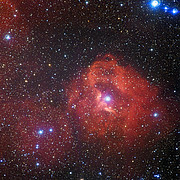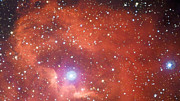Komunikat prasowy
Badania w szkarłacie
16 kwietnia 2014
Nowe zdjęcie z Obserwatorium ESO La Silla w Chile prezentuje obłok wodoru o nazwie Gum 41. W środku tej mało znanej mgławicy znajdują się jasne, gorące, młode gwiazdy, których energetyczne promieniowanie powoduje, że wodór wokół świeci w charakterystycznym czerwonym odcieniu.
Ten obszar na niebie południowym w konstelacji Centaura jest domem wielu jasnych mgławic, z których każda powiązana jest z nowo narodzonymi, gorącymi gwiazdami , które uformowały się z obłoków gazu wodorowego. Intensywne promieniowanie od gwiezdnych noworodków wzbudza wodór, który pozostał wokół nich, powodując, że gaz ma charakterystyczny odcień czerwieni typowy dla obszarów gwiazdotwórczych. Słynnym przykładem tego zjawiska jest Mgławica Laguna (eso0936) – olbrzymi obłok, który świeci w podobnym jasnym odcieniu szkarłatu.
Mgławica zaprezentowana na zdjęciu znajduje się 7300 lat świetlnych od Ziemi. Odkrył ją australijski astronom Colin Gum na fotografiach wykonanych w Obserwatorium Mount Stromlo koło Canberry. Gum zawarł swoje odkrycie w katalogu 84 mgławic emisyjnych opublikowanym w 1955 roku. Gum 41 jest w rzeczywistości małą częścią większej struktury o nazwie Mgławica Lambda Centauri, znanej też pod bardziej egzotycznym określeniem Mgławica Biegnący Kurczak (inna jej część została pokazana w eso1335). Gum zmarł tragicznie w młodym wieku podczas wypadku narciarskiego w Szwajcarii w 1960 roku.
Na zdjęciu Gum 41 obłoki wydają się być całkiem grube i jasne, ale to złudzenie. Gdyby hipotetyczny astronauta podróżował przez mgławicę, najprawdopodobniej wcale by tego nie zauważył – nawet z bliska – byłaby zbyt słaba dla ludzkiego oka. Pozwala to wytłumaczyć dlaczego tak wielki obiekt musiał czekać na odkrycie do połowy dwudziestego wieku – jego światło jest bardzo słabe, a czerwonej barwy nie jest łatwo dostrzec wizualnie.
Nowy portret Gum 41 – chyba jeden z najlepszych do tej pory – został utworzony z danych zebranych instrumentem Wide Field Imager (WFI) na 2,2-metrowym teleskopie MPG/ESO w Obserwatorium La Silla w Chile. Jest połączeniem zdjęć wykonanych w filtrach niebieskim, zielonym i czerwonym oraz fotografii w specjalnym filtrze zaprojektowanym do wychwycenia czerwonego koloru wodoru.
Więcej informacji
ESO jest wiodącą międzyrządową organizacją astronomiczną w Europie i najbardziej produktywnym obserwatorium astronomicznym na świecie. Jest wspierane przez 15 krajów: Austria, Belgia, Brazylia, Czechy, Dania, Finlandia, Francja, Hiszpania, Holandia, Niemcy, Portugalia, Szwajcaria, Szwecja, Wielka Brytania oraz Włochy. ESO prowadzi ambitne programy dotyczące projektowania, konstrukcji i użytkowania silnych naziemnych instrumentów obserwacyjnych, pozwalając astronomom na dokonywanie znaczących odkryć naukowych. ESO odgrywa wiodącą rolę w promowaniu i organizowaniu współpracy w badaniach astronomicznych. ESO zarządza trzema unikalnymi, światowej klasy obserwatoriami w Chile: La Silla, Paranal i Chajnantor. W Paranal ESO posiada Bardzo Duży Teleskop (Very Large Telescope), najbardziej zaawansowane na świecie astronomiczne obserwatorium w świetle widzialnym oraz dwa teleskopy do przeglądów. VISTA pracuje w podczerwieni i jest największym na świecie instrumentem do przeglądów nieba, natomiast VLT Survey Telescope to największy teleskop dedykowany przeglądom nieba wyłącznie w zakresie widzialnym. ESO jest europejskim partnerem dla rewolucyjnego teleskopu ALMA, największego istniejącego projektu astronomicznego. ESO planuje obecnie 39-metrowy Ekstremalnie Wielki Teleskop Europejski (European Extremely Large optical/near-infrared Telescope - E-ELT), który stanie się “największym okiem świata na niebo”.
Linki
- Zdjęcia 2,2-metrowego teleskopu MPG/ESO
- Zdjęcia wykonane za pomocą 2,2-metrowego teleskopu MPG/ESO
- Zdjęcia La Silla
Kontakt
Richard Hook
ESO Public Information Officer
Garching bei München, Germany
Tel.: +49 89 3200 6655
Tel. kom.: +49 151 1537 3591
E-mail: rhook@eso.org
Krzysztof Czart (Kontakt dla mediów Polska)
Sieć Popularyzacji Nauki ESO
oraz Urania - Postępy Astronomii
Toruń, Polska
Tel.: +48 513 733 282
E-mail: eson-poland@eso.org
O komunikacie
| Komunikat nr: | eso1413pl |
| Nazwa: | Gum 41 |
| Typ: | Milky Way : Nebula : Type : Star Formation |
| Facility: | MPG/ESO 2.2-metre telescope |
| Instrumenty: | WFI |
Our use of Cookies
We use cookies that are essential for accessing our websites and using our services. We also use cookies to analyse, measure and improve our websites’ performance, to enable content sharing via social media and to display media content hosted on third-party platforms.
ESO Cookies Policy
The European Organisation for Astronomical Research in the Southern Hemisphere (ESO) is the pre-eminent intergovernmental science and technology organisation in astronomy. It carries out an ambitious programme focused on the design, construction and operation of powerful ground-based observing facilities for astronomy.
This Cookies Policy is intended to provide clarity by outlining the cookies used on the ESO public websites, their functions, the options you have for controlling them, and the ways you can contact us for additional details.
What are cookies?
Cookies are small pieces of data stored on your device by websites you visit. They serve various purposes, such as remembering login credentials and preferences and enhance your browsing experience.
Categories of cookies we use
Essential cookies (always active): These cookies are strictly necessary for the proper functioning of our website. Without these cookies, the website cannot operate correctly, and certain services, such as logging in or accessing secure areas, may not be available; because they are essential for the website’s operation, they cannot be disabled.
Functional Cookies: These cookies enhance your browsing experience by enabling additional features and personalization, such as remembering your preferences and settings. While not strictly necessary for the website to function, they improve usability and convenience; these cookies are only placed if you provide your consent.
Analytics cookies: These cookies collect information about how visitors interact with our website, such as which pages are visited most often and how users navigate the site. This data helps us improve website performance, optimize content, and enhance the user experience; these cookies are only placed if you provide your consent. We use the following analytics cookies.
Matomo Cookies:
This website uses Matomo (formerly Piwik), an open source software which enables the statistical analysis of website visits. Matomo uses cookies (text files) which are saved on your computer and which allow us to analyze how you use our website. The website user information generated by the cookies will only be saved on the servers of our IT Department. We use this information to analyze www.eso.org visits and to prepare reports on website activities. These data will not be disclosed to third parties.
On behalf of ESO, Matomo will use this information for the purpose of evaluating your use of the website, compiling reports on website activity and providing other services relating to website activity and internet usage.
Matomo cookies settings:
Additional Third-party cookies on ESO websites: some of our pages display content from external providers, e.g. YouTube.
Such third-party services are outside of ESO control and may, at any time, change their terms of service, use of cookies, etc.
YouTube: Some videos on the ESO website are embedded from ESO’s official YouTube channel. We have enabled YouTube’s privacy-enhanced mode, meaning that no cookies are set unless the user actively clicks on the video to play it. Additionally, in this mode, YouTube does not store any personally identifiable cookie data for embedded video playbacks. For more details, please refer to YouTube’s embedding videos information page.
Cookies can also be classified based on the following elements.
Regarding the domain, there are:
- First-party cookies, set by the website you are currently visiting. They are stored by the same domain that you are browsing and are used to enhance your experience on that site;
- Third-party cookies, set by a domain other than the one you are currently visiting.
As for their duration, cookies can be:
- Browser-session cookies, which are deleted when the user closes the browser;
- Stored cookies, which stay on the user's device for a predetermined period of time.
How to manage cookies
Cookie settings: You can modify your cookie choices for the ESO webpages at any time by clicking on the link Cookie settings at the bottom of any page.
In your browser: If you wish to delete cookies or instruct your browser to delete or block cookies by default, please visit the help pages of your browser:
Please be aware that if you delete or decline cookies, certain functionalities of our website may be not be available and your browsing experience may be affected.
You can set most browsers to prevent any cookies being placed on your device, but you may then have to manually adjust some preferences every time you visit a site/page. And some services and functionalities may not work properly at all (e.g. profile logging-in, shop check out).
Updates to the ESO Cookies Policy
The ESO Cookies Policy may be subject to future updates, which will be made available on this page.
Additional information
For any queries related to cookies, please contact: pdprATesoDOTorg.
As ESO public webpages are managed by our Department of Communication, your questions will be dealt with the support of the said Department.




